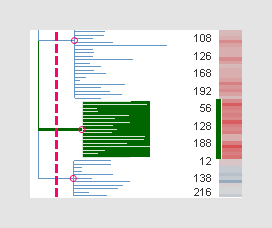Dendrogram data table format
A dendrogram can be imported and used in a heat map via a data table, provided that it follows the format specified in this topic.
The column headers in the data table must be named exactly as seen below, and have the appropriate type:
- NodeID (integer)
- ParentID (integer)
- PruningLevel (integer)
- Height (numeric)
- LeafOrder (integer)
- + one or more Leaf Identifier Columns

In this table, each row corresponds to a node in the dendrogram and its associated attributes. In the dendrogram below, the NodeID of each node has been indicated by a number.

NodeID
The NodeID provides a unique number for each node in the dendrogram.
ParentID
Combined with the NodeID, the ParentID determines the hierarchy of the dendrogram. For each NodeID, the corresponding ParentID states which node is its parent. For example, node 2 has the parent 6, which in turn has parent 7, which in turn has parent 10, which in turn has parent -1. Since -1 is not present in the NodeID column, that means -1 is a root node. Note that there can be several root nodes. Every unique ParentID that does not match a NodeID will be interpreted as a root node.
PruningLevel
The PruningLevel is additional information, needed to interpret prunings as cluster columns. From a PruningLevel, the system finds the associated closest node in a pruning perspective as follows: Think of all rows as branches. Prune all branches < PruningLevel. Then you will have a set of remaining nodes. Then remove all nodes whose parent is among the remaining nodes.
In the example above, this means:
- Prune at level 0 -> One node (10) will be found.
- Prune at level 1 -> Two nodes (7, 9) will be found.
- Prune at level 2 -> Four nodes (0, 5, 6, 8) will be found.
- Prune at level 3 -> Six nodes (0, 1, 2, 3, 4, 5) will be found, all leaves.
Height
The Height determines the position of the node. For a row dendrogram as in the example above, this means the horizontal position relative the edge of the heat map. In the example, all leaves have height 0, thus they begin closest to the heat map. Each parent must have an increasing value, as they come closer to the root of the dendrogram.

LeafOrder
Each row that is a leaf, must have a LeafOrder number. These numbers state the order of the leaves. Nodes that are not leaves have an empty value.
Additional leaf identifier columns
Additional columns in the dendrogram data table are leaf identifier columns. In the example above, there is only one identifier column, but it is quite possible to have several. The leaf identifier columns are used to match and sort the heat map.